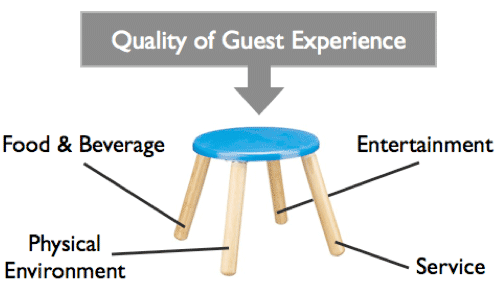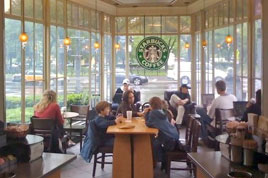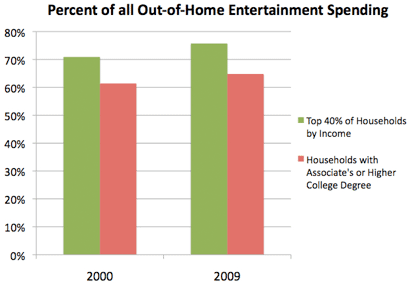The foundation of location-based entertainment success is a four-legged stool
by Randy White, CEO
We all know what happens if you sit on a four-legged stool if the legs aren’t all the same length or one leg is weak and breaks – you can end up with your butt on the floor. Well, a location-based entertainment (LBE) center, such as a family entertainment center (FEC) or a bowling center, is much like a four-legged stool: there is a foundation of four legs, or essential components, that create the guest experience and overall guest satisfaction. Guest satisfaction is what ultimately determines the attendance and per capita spending that generates the LBE’s revenues and profits. If any one of the legs is weak guest satisfaction suffers and the business can end up on its butt, or worse, in bankruptcy. The four legs that create an LBE’s guest experience are entertainment, service, food and beverage and the physical environment.

Entertainment and Service
Without question, every LBE owner, manager or aspiring entrepreneur understands and focuses on the entertainment mix. They also, as consumers themselves, instinctively tend to understand the importance of delivering great service to their guests, which has become even more important in these economic times. 61% of Americans report that customer service is more important today than in the past and 9% (7%-9% in different European countries) say they will spend more money with a company that provides excellent service.
Where we see many shortcomings at LBEs, including in the underperforming ones our company is called in to evaluate and develop a turnaround plan for, are the two other legs of the stool: the food and beverage and the physical environment.
Food and Beverage
First, let’s discuss food and beverage. For years, the LBE industry, and especially the more community-based facilities such as a family and children’s entertainment centers and bowling centers, treated foodservice as secondary to everything else. Most facilities only offered a snack bar or concession stand and we all know what the basic menu usually was – pizza (often a frozen premade product), hot dogs, nachos and cheese, and popcorn. Some went a little further and offered hamburgers and sandwiches, but regardless, the food was nothing to write home about.
A lot has changed in the last decade or so. Consumers are much more knowledgeable about food and sophisticated in the food profiles they desire as a result of their experiences in restaurants. Two-thirds of Americans now snack sometime between lunch and dinner and are looking for better options than nachos and cheese. 70% of moms consider the availability of healthy kid food and beverages important to their choice of where their family dines. Many consumers have dietary needs that they take with them when they eat out: low fat, low salt, low calorie, high fiber, organic, gluten-free and free of particular allergens, to just name a few. The snack bar or concession stand offerings no longer cut it.
Good food, what we call destination dining—a place you would go for a meal—is essential in order to drive attendance at most types of LBEs. Americans eat out far more frequently than they seek out-of-home entertainment. The average American sits down for a meal in a restaurant 78 times year, yet the average American only goes to the cinema 4.4 times a year. An LBE with appealing destination dining can attract attendance for its food as well as its entertainment. It’s known as come for the food and stay for the fun, offering the consumer a time-saving one-stop synergistic experience. Customers at an LBE without good food will leave to go elsewhere to dine when its meal time or even for a snack.
The community-based LBEs that have survived the test of time, what we call the evergreens, all generate approximately 50% of their sales from food and beverage. Examples include Dave & Buster’s and Chuck E. Cheese’s, both of which have been around for over 25 years. The success of the pizza buffet entertainment centers, such as John’s Incredible Pizza, is built on that 50:50 formula. Eatertainment concepts such as these generate revenue per square foot anywhere from 3 to 4 times what community-based entertainment-only centers achieve.
Our company tells our clients to take this perspective on foodservice. Rather than consider yourself as developing or operating an entertainment venue that serves food, think of the business as a restaurant that also offers entertainment.
Physical Environment
Now for the second frequently neglected leg of the stool – the physical environment.
The physical environment has a powerful influence on guest emotions and feelings, which in turn affect guests’ behavior, including whether they want to stay and spend their money or leave and never return. The environment, which includes the layout, finishes, colors, lighting, scale of the space, seating, ambiance, aromas, music, acoustics, etc., has an impact often experienced only on a subconscious level, but nevertheless has an effect on emotions and behavior. An LBE wins when it consciously creates the right environment, what we call ‘quality-of-place’, that matches the desired experience, as well as reflects and matches the values, tastes and preferences of the targeted niche of guests.
“Every Starbucks store is carefully designed to enhance the quality of everything the customers see, touch, hear, smell or taste.”
Howard Schultz
Consumers have high expectations for quality-of-place based upon all the other out-of-home businesses they frequent, including restaurants, stores, malls and even airports. Those expectations carry over to LBEs, which consumers expect to be just as nice.
 Unfortunately, many LBEs, FECs and bowling centers come no where close to matching the expectations of their targeted guests for the quality of the physical environment, and then they wonder why their business isn’t doing better. Many indoor FECs are like carnivals in a warehouse, and many outdoor family fun centers are concrete deserts.
Unfortunately, many LBEs, FECs and bowling centers come no where close to matching the expectations of their targeted guests for the quality of the physical environment, and then they wonder why their business isn’t doing better. Many indoor FECs are like carnivals in a warehouse, and many outdoor family fun centers are concrete deserts.
Gender
Design can be gender specific. Women perceive and experience environments differently than men do. Women are much more discriminating and pay closer attention to décor, colors, fabrics, aroma, cleanliness and lighting. Men respond to structural elements. Women like textures, softness and curves. Men like right angles, boxy designs and metallic finishes. Women like more intimate spaces with lower ceilings; men like cavernous spaces with high ceilings. Women like brighter spaces, men often like darker environments.
Some facilities target women, the primary decision maker, very successfully through their quality-of-place. A good example is the highly successful American restaurant chain, Panera Bread. It has a softer, intimate feel and subdued colors that appeal to women. Most classic white-tablecloth steak houses with their heavy dark wood finishes and lower lighting levels appeal to men. The Cheesecake Factory is a good example of an environment with a balanced gender appeal. Women relate to its soft, warm colors, good lighting and fine finishes like marble. At the same time, men don’t feel out of place because of its strong architecture with large columns, beams and crown moldings.
Socioeconomic-/lifestyles
Not only is there a difference in genders’ perception of environments and quality-of-place, there is also a difference based upon people’s socio-economics/lifestyles (SELs). This is driven not so much by their incomes, but more so by their education levels. There is an old saying that holds enormous truth, “Birds of a feather flock together”. People like to hang out in environments with people like themselves. You have to design the nest, the environment, for the particular variety of bird you want to attract.
SELs vary not only based upon socio-economics, but also based on lifestyle factors including needs, tastes, preferences, values, hopes and fears, all of which are important in customizing an appealing entertainment experience and brand. Denny’s restaurant designs its environment to appeal to a much lower SEL than does McCormick & Schmick’s Seafood Restaurant. Often, the SEL group that loves one of these restaurants won’t be caught dead in the other; it doesn’t match their SEL and self-image. The same holds true for Walmart and Target. Target has a much higher level of finish and has more design-oriented merchandise than Walmart, and therefore attracts a higher SEL.
High income and well educated households now account for the majority of all spending at LBEs:
- Households in the top 40% by incomes account for three-quarters (76%) of all out-of-home entertainment spending.
- Those in the top 20% by income account for 55%.
- And those households with adults with an Associate’s or higher degree account for 65% of all such spending.
There is an increasing social stratification of out-of-home entertainment spending shifting to these higher SELs. Each year high income and well-educated consumers account for an increasing percentage of all out-of-home entertainment spending.
These higher SELs have sophisticated tastes and high expectations for quality-of-place. Many LBEs that would like to attract their business, especially their high repeat business, don’t as a result of not matching their expectations for the quality of the environment. In fact, many LBEs drive these prime SEL customers away because of their atmosphere. One example is acoustics. Loud and reverberant interiors induce physiological stress in the body. Creating stress is just the opposite of what you want for guests who are going out to socialize and have a good time together. Not only is a loud and noisy environment stressful, but it also makes it difficult to socialize when you can’t hold a conversation without raising your voice.
Price Perception
There is a lot of supporting research in the restaurant industry on the importance of the quality-of-place to success. Studies show that the quality of the physical surroundings strongly influence both customer satisfaction and price perception—whether the business is seen as offering a good value for the price—both of which where found to in turn affect loyalty and repeat business. Other research indicates that consumers are even more focused on getting a good value for their money today than in pre-recession times, making value perception increasingly important. The restaurant studies also found that food quality does not significantly affect positive emotions such as joy, excitement or peacefulness, whereas the physical environment did. In other words, the atmosphere and finishes of a restaurant are more important to customers feeling good about the overall experience than the food. And surprisingly, research has found that loud background noise can make the food taste bland. There is no reason that these findings cannot be extrapolated to location-based entertainment facilities, especially since foodservice is becoming such an important part of the mix.
Today consumers have many entertainment options, including just staying home and watching a movie on their in-home entertainment systems, play mock bowling on Wii, or cruising the internet. In order to succeed, bricks-and-mortar out-of-home entertainment experiences have to be very compelling and offer a good value in order to lure consumers out of their homes. All legs of the four-legged stool of guest experience are vital to an LBE’s success, but the physical environment and food and beverage offerings are of increasing importance. Don’t forget them or let them be secondary to the entertainment and service. Make sure the four-legged stool stays solid and upright.
Additional reading:


